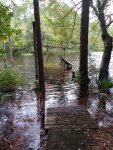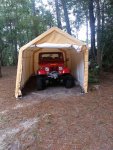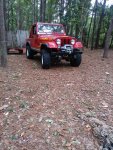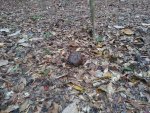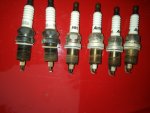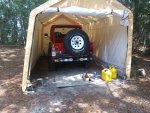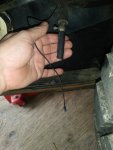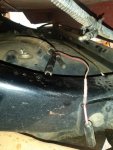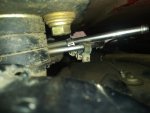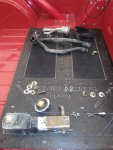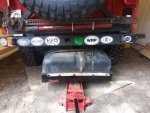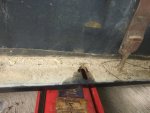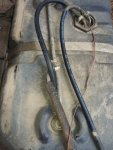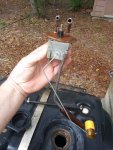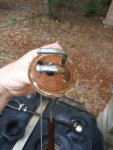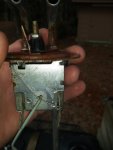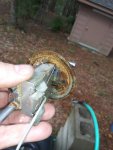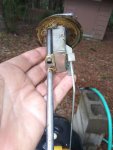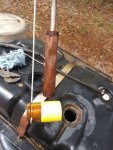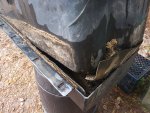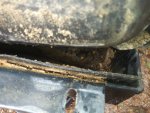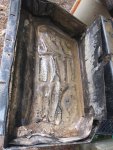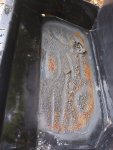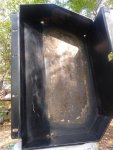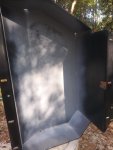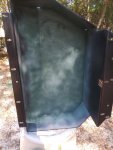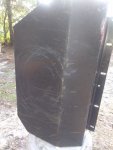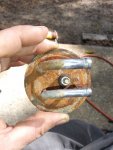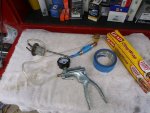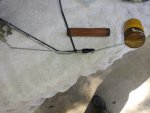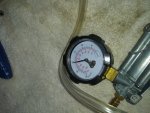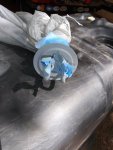- City
- Biloxi
- State
- MS
I see a few millimeters on the motor +/- allen head that could be ground off
Maybe


I see a few millimeters on the motor +/- allen head that could be ground off

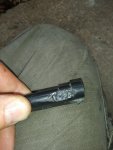
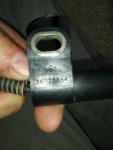
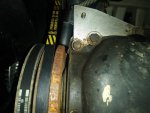
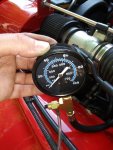
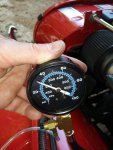
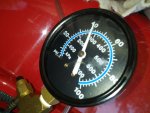
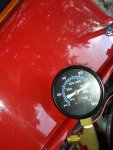
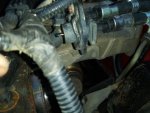
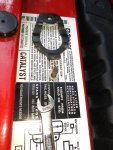
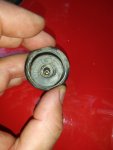
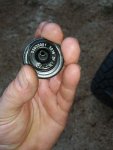
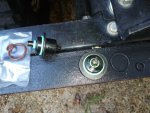
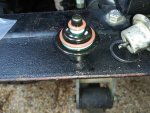
So you have all the jeeps buttoned up ? The storm was heading to us but looks like it has now turned east, hopefully east of you some
My green Scrambler and JeepAddict's red Scrambler inside my garage, Gladiator blocking garage doors. My poor red Scrambler is in the yard under the Harbor Freight canopy. If the wind gets too bad I will pull the red Scrambler out of the canopy thing and park it right next to the house to be safer.
Hopefully we just get a bunch of rain for a few days, with just some stronger wind gusts. If all I have to do is pick up the yard for a few days I will be very happy.
Had to pull my skiff up the cliff some more, Tchoutacabouffa River is already pretty high. Not worried about house flooding, it sits about 50' higher then the water on a high bluff.
Hope and pray everyone else down here fairs well.
Its a shame all this rain can't make it out to California/Washington/Oregon and the other wild fire western states.
I’ve really been enjoying this build thread. Especially your attention to detail while describing what you’re doing. Thank you for that! I hope everything works out OK with your weather. I’m out in California well below the creek fire. Horrible air quality, and it has sure displaced lots of people. We’d love to have some of your rain for sure. I’m not sure these fires are going to be contained without a good rain storm. Unfortunately our rain season usually doesn’t start until the end of October, to the end of November.


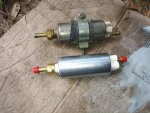
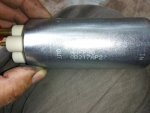
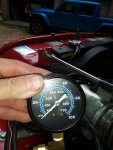
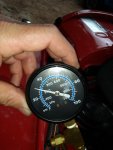


I am confused by this. The one way valve was a common issue on some GM vehicles and would give similar symptoms, mainly long cranking until rail pressure makes the EFI happy. You could cycle the key once or twice and they typically would start right up. The thing I don't get with yours is that pressure increases, then drops to 0 until it starts while cranking.
Does your fuel pump run for the entire time you cycle the key (or at least for like 5 seconds)? Its weird that pressure goes up then drops off to 0. Since the FPR is not electric, it seems that anytime that the pump is started, pressure should build to 41 and hold. The GM TBI has a function that will turn your fuel pump off if you lose oil pressure. It also uses crank signal to turn the fuel pump on of the key was held in the "run" position long enough to turn the pump off.
The redneck way/sanity check to test this would be to unhook the fuel pump from its harness and run 12V directly to it then monitor fuel pressure. If you wire the pump directly to the battery and it holds fuel pressure and starts better, it does give a direction to look.

Wish I had seen that valve years ago- I bought one from Ford- it was close to $100...and it’s still sitting in my tool box. One of these-Swapped over fuel pumps yesterday afternoon. The top pump has been on here for 40k miles, the original supplied Hesco pump that came with the kit. I swapped on a replacement pump I purchased from Hesco awhile back, I usually keep two spares on hand.
View attachment 87047
The replacement pump is slightly longer, so from a different batch/supplier perhaps.
Part number on the replacement pump. A quick Google search provides no information on this pump?
View attachment 87048
Only took about 30 minutes to swap pumps, the best benefit of using an external fuel pump.
A few quick "key on/off", still not holding pressure with key ON/engine off:
View attachment 87049
BUT, one major change: When the key is turned ON, the pressure jumps to 41psi, then quickly drops to zero. So, I would guess this pump is working better then the one I pulled off? It quickly hits 41psi, then drops off. So, the engine does start up now within 3 seconds of twisting the key to "Start". So, it does start easier than before.
Pressure at idle, holding steady at 30 psi like it should be:
View attachment 87050
One other observation: With the old pump, the needle on the pressure gauge was fluctuating/bouncing 3-4psi. With the new pump, the needle stays rock steady.
So, did I fix it? I guess so. Starts up within 3 seconds of twisting the key to start, so no more long starting issue, so happy about that.
One thing I can't remember: With this two rail system, external aftermarket pump, FPR on the fuel rail, did the rail ever hold pressure after simply turning the key to "ON"? There is no one way check valve on the fuel supply side, so it stands to reason that without the pump running, nothing to hold pressure at the fuel rail? The fuel pump pressurizes the rail instantly, then the pump quits running without twisting the key to START, so the fuel/pressure just bleeds off down the supply side line?
On OEM Jeep 4.0 fuel systems, there is a check valve built into the pump/regulator/filter assembly. Even though I am using a Mopar MPI kit, it does NOT use an OEM fuel pump module.
On my green Scrambler, with the single line fuel rail, the pressure regulator/filter is after the pump back by the tank. So, key ON, the fuel rail will hold pressure/fuel without having to go to START. The pressure will eventually bleed off, but it takes 20-30 minutes IIRC.
Common complaint with OEM Jeep 4.0's, especially the Cherokees, is this check valve going bad resulting in long cranking times before the engine will start.
On this red Scrambler, it had always started easily, just not instantly, but no more then 3 seconds. So, maybe it has always been like this? It is kind of funny, but when I start it, I almost know when to release the key, even before it fires off. About 3 seconds crank, I presume the fuel pressure at the rail hits and holds its 41psi, it fires right off, no drama.
Will probably research some more, but I "might" put a one way check valve on the fuel supply line AFTER the pump. This will prevent the fuel from bleeding back down the supply line, allowing the rail to hold pressure.
My pump puts out 80-90 psi, BUT I have the pressure regulator on the rail. So, the check valve will hold pressure/fuel at the rail, the FPR will bleed off the excess over 40psi pressure down the return line, should not be a problem
Something like this:
https://www.highflowfuel.com/i-2390...Q2Ylgyh-UlKN6SzJfnWXfYbf1qX2cc8hoCC18QAvD_BwE
Thoughts or opinions?
One other thought: this could all be operator error. I usually turn the key to "ON", wait for the check engine light to turn "OFF" (about 5-6 seconds), then twist the key to "START". So, pressure builds up like it should, then drops off, then I twist key to Start while pressure is dropping or at zero.
Maybe the next few starts I will just twist the key straight to Start, no pause at On waiting for the CEL to go off, like a normal car. Stands to reason this should work better since the fuel pressure gauge shows 41psi as soon as key is initially twisted to On. While the engine is cranking, the fuel pump is running continuously maintaining the correct fuel pressure.
Maybe I am the cause of my "hard starts"

YikesWish I had seen that valve years ago- I bought one from Ford- it was close to $100...and it’s still sitting in my tool box. One of these-
View attachment 87090

